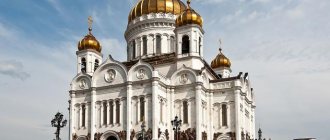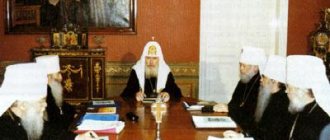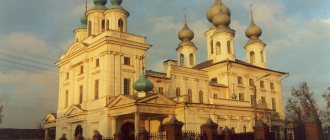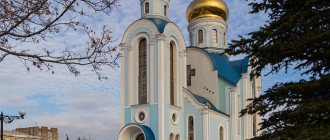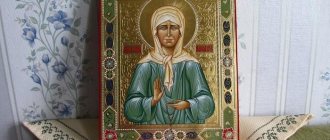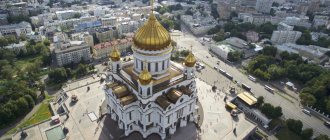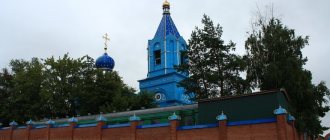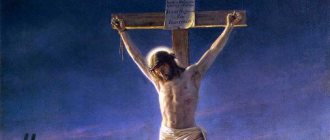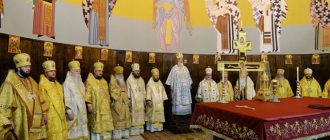Story
The history of the capital's diocese is directly related to the development of the All-Russian metropolitans' own possessions. Moscow became the permanent residence of the head of the Russian Church in 1325. His possessions included Moscow, Vladimir, Nizhny Novgorod and more than 10 other cities located in the center of the Russian plain.
Gradually the possessions grew, and in order to manage them it became necessary to transfer part of the bishop's responsibilities to an assistant. For some time this duty was performed by the bishops of Kolomna.
After the see of the Sarai diocese was moved to the Moscow region and placed in Krutitsy, Bishop Krutitsy received the status of vicar of the Moscow bishop. After its establishment at the end of the 16th century. Russian Patriarchate, the deputy of the patriarch received the title of Metropolitan of Krutitsky.
The Cathedral of Christ the Savior is the cathedral of Moscow
At the beginning of the 18th century, the vast estates of the church rulers came under the control of the Synod. For 40 years the diocese did not have an official bishop and was headed by Bishop Krutitsky. A separate Moscow diocese was established in 1742 at the behest of Empress Elizabeth Petrovna. It included vast territories belonging to the Moscow, Tambov, Belgorod, Voronezh, Kazan, Novgorod and Arkhangelsk provinces.
During the second half of the 18th century. The patriarchal see underwent many territorial and administrative changes. One of the most active heads of the diocese was Metropolitan Platon Levshin. Under him, the Slavic-Greek-Latin Academy and about a dozen monasteries came under Moscow jurisdiction.
Interesting! The bishop established the regular work of the diocesan administration and paid great attention to the organization of theological schools. Metropolitan Plato was also the author of many sermons, akathists and theological works.
In 1917, with the revival of the Russian Patriarchate, the status of the patriarchal region was also restored. By decree of Patriarch Tikhon, Iosaf was appointed its manager, who received the title of Archbishop of Kolomna and Krutitsky. The persecution of the church, which began with the Bolsheviks coming to power in the country, complicated the situation of the clergy.
In the 20-40s. At the same time as the canonical diocese, there was a renovation department. Due to repressions until the early 40s. The leaders of the patriarchal estates changed frequently.
Since 1945, the metropolitans of Krutitsky were officially assigned the functions of administrators of the Moscow diocese. In the second half of the 20th century. The following clergy were the vicars of the patriarch:
- Nikolai Yarushevich;
- Pitirim Svirodov;
- Seraphim Nikitin;
- Yuvenaly Poyarkov.
Metropolitan Yuvenaly has been the Metropolitan of Krutitsky to this day. The Bishop accepted a small diocese, in which there was no monastic life and 132 parishes functioned. Currently, the diocese includes 493 parishes, 33 monastic communities with a total number of inhabitants of about 2,000 people. Active temple construction is underway in the capital and region.
Patriarch of Moscow and All Rus' Kirill - head of the Moscow diocese
Currently, the Moscow diocese consists of two virtually independent parts, which have an independent management structure. Its head is the Patriarch of Moscow and All Rus', and the Metropolitan of Krutitsky and Kolomna helps him in managing his vast domains.
Links
| Dioceses of the Russian Orthodox Church | |
| Dioceses of direct subordination | |
| Russia | Abakanskaya • Almetyevskaya • Amurskaya • Anadyrskaya • Ardatovskaya • Arsenyevskaya • Arkhangelskaya • Astrakhanskaya • Balashovskaya • Barnaulskaya • Baryshskaya • Bezhetskaya • Belgorodskaya • Belevskaya • Birobidzhanskaya • Blagoveshchenskaya • Bratskaya • Borovichskaya • Bryanskaya • Buzulukskaya • Valuyskaya • Vladivostokskaya (Ussuri Vicariate) • Vladika vkazskaya • Vladimir ( Murom Vicariate ) • Volgograd • Volgodonsk • Vologda • Voronezh ( Ostrogozh Vicariate ) • Vyksa • Vyatskaya • Georgievsk • Gorodets • Gubkin • Ekaterinburg • Ekaterinodar ( Yeisk Vicariate ) • Yenisei • Zheleznogorsk • Ivanovo-Voznesensk • Izhevsk • Irkutsk • Isilkul • Iskitimskaya • Yoshkar-Olinskaya • Kazan • Kainskaya • Kalachevskaya • Kalachinskaya • Kaliningrad ( Baltic Vicarism ) • Kaluga ( Lyudinovskoye Vicarism ) • Kamenskaya • Kanashskaya • Karasukovskaya • Kasimovskaya • Kemerovskaya • Kinelskaya • Kinesemskaya • Krasnoslobodskaya • Krasnoyarskaya • Krasnoyarskaya • Krasnoyarsk • Krasnoyarsk Kuznetsk • Kurgan • Kursk • Kyzyl • Lipetsk • Lyskovsk • Magadan • Magnitogorsk • Maikop • Mariinsk • Melekess • Moscow (city) ( vicariate: Bronnitskoe | Vereiskoe | Volokolamsk | Voskresenskoe | Dmitrovskoe | Egoryevskoe | Istra | Kashirskoe | Klinskoe | Krasnogorskoe | Naro-Fominskoe | Podolsk | Sergiev Posad | Solnechnogorskoe | Trinity ) • Moscow (regional) ( vicariates: Balashikha | Vidnovskoye | Zaraiskoye | Mozhaiskoye | Serpukhovskoye ) • Murmansk • Naryan-Mar • Nakhodka • Neftekamsk • Nizhny Novgorod • Nizhny Tagil • Novgorod • Novosibirsk • Novokuznetsk • Omsk • Orenburg • Oryol • Orsk • Otradnensk • Penza • Perm • Petrozavodsk • Petropavlovsk • Pokrovskaya • Pskov • Pyatigorsk • Rzhev • Rostov • Rybinsk • Ryazan • Salavat • Salekhard • Samara • St. Petersburg ( vicariates: Vyborg | Gatchina | Lodeinopolskoye | Peterhof ) • Saransk ( Ruzaevsky vicariate ) • Saratov • Sayan • Serdob • Simbirsk • Skopinsk • Smolensk • Stavropol • Syktyvkar • Tambov • Tara • Tver • Tobolsk • Tomsk • Trinity • Tula • Ulan-Ude • Urzhum diocese • Uryupinsk • Ufa • Khabarovsk (vicariates: Bikinskoe | Nikolaevskoe ) • Khanty-Mansiysk • Cheboksary ( Alatyr Vicariate ) • Chelyabinsk • Chistopol • Chita • Shakhtinskaya • Shuyskaya • Shchigrovskaya • Elista • Yuzhno-Sakhalinskaya • Yakutskaya • Yaranskaya • Yaroslavlskaya |
| other countries | Argentine • Baku • Berlin • Brussels • Budapest • Vienna • Vilna • The Hague • Korsun • Sourozh ( Kerch Vicariate ) |
| Autonomous churches | |
| Chinese PC | Beijing • Xinjiang • Tianjin • Harbin • Shanghai |
| Japanese PC | Kyoto • Sendai • Tokyo |
| Self-governing churches | |
| Ukrainian PC | Alexandria • Belotserkovskaya ( Rakitnyansk Vicariate ) • Berdyansk • Vinnytsia • Vladimir-Volynsk • Voznesenskaya • Gorlovskaya • Dzhankoyskaya • Dneprodzerzhynskaya • Dnepropetrovskaya ( Novomoskovskaya Vicariate ) • Donetsk ( vicariates: Makeyevskoe | Svyatogorsk ) • Zhytomyr • Zaporozhye • Ivano-Frankivsk • Izya mskaya • Kamenets -Podolsk • Kiev ( vicariates: Belogorodskoe | Boryspilskoe | Brovarskoe | Vasylkivskoe | Vyshgorodskoe | Gorodnitskoe | Makarovskoe | Pereyaslav-Khmelnitskoe | Pochaevskoe | Putivlskoe | Yagotinskoe ) • Kirovogradskaya • Konotopskaya • Kremenchugskaya • Krivorozhskaya • Luganskaya • Lutskaya • Lvovskaya Mukachevo • Nizhynskaya • Nikolaevskaya • Новокаховская • Овручская • Одесская ( Белгород-Днестровское викариатство ) • Полтавская • Ровенская ( Дубновское викариатство ) • Сарненская • Северодонецкая • Симферопольская • Сумская • Тернопольская • Тульчинская • Уманская • Харьковская • Херсонская • Хмельницкая • Хустская • Черкасская • Черниговская • Черновицкая ( викариатства : Banchenskoe | Khotinskoye ) • Shepetovskaya |
| Human Rights Center of Moldova | Balti • Edinet • Cahul • Chisinau • Tiraspol • Ungheni |
| Latvian PC | Rizhskaya ( Daugavpils Vicariate ) |
| Estonian Human Rights Center | Narvskaya • Tallinskaya |
| ROCOR | Berlin ( Stuttgart Vicariate ) • British • East American ( Manhattan | Mayfield Vicariates ) • Geneva • Montreal • San Francisco ( Seattle Vicariate ) • Sydney • Chicago ( Cleveland Vicariate ) • South American |
| Exarchates | |
| Belarusian Exarchate | Bobruisk • Brest • Vitebsk ( Drutsk Vicariate ) • Gomel • Grodno • Minsk ( Borisov Vicariate ) • Mogilev • Novogrudok • Pinsk • Polotsk • Turov |
| Metropolitan districts | |
| Kazakhstani | Astana ( Kaskelen Vicariate ) • Karaganda • Kostanay • Kokshetau • Pavlodar • Petropavlovsk • Ural • Ust-Kamenogorsk • Chimkent |
| Central Asian | Bishkek • Dushanbe • Tashkent • Patriarchal parishes in Turkmenistan |
| Patriarchal parishes of the Moscow Patriarchate | |
| Italy • Canada • USA • Finland | |
| Deanery of the Moscow Diocese | |
| Moscow region | |
| Balashikhinskoye • Bogorodskoye • Bronnitskoye • Vidnovskoye • Volokolamskoye • Voskresenskoye • Dmitrovskoye • Dolgoprudnenskoye • Domodedovskoye • Dubnensko-Taldomskoye • Egoryevskoye • Zaraiskoye • Zvenigorodskoye • Istraskoye • Kashirskoye • Klinskoye • Kolomenskoye • Krasnogorskoye • Losino-Petrovskoye • Lotoshinskoye • Lukhovitskoye • Lyuberetskoye • Mozhaiskoye • Mytishchinskoye • Naro-Fominskoye • Odintsovo • Ozyorskoye • Orekhovo-Zuevskoye • Pavlovo-Posadskoye • Podolskoye • Pushkinskoye • Ramenskoye • Ruzskoye • Sergiev-Posadskoye • Serebryano-Prudskoye • Serpukhovskoye • Solnechnogorskoye • Stupinskoye • Khimkinskoye • Chekhovskoye • Shaturskoye • Shakhovskoye • Shchelkovskoye • Monastyrskoye • Edinoverie parishes | |
| Moscow City Diocese | |
| Andreevskoye (South-Western Autonomous District) • Bogoyavlenskoye (Basmanny and Krasnoselsky Districts of the Central Autonomous District) • Vsekhsvyatskoye (Northern Autonomous District) • Danilovskoye (Southern Autonomous District) • Zelenogradskoye (Zelenograd Autonomous District) • Georgievskoye, Mikhailovskoye (Western Autonomous District) • Moskvoretskoye ( Districts "Zamoskvorechye" and "Yakimanka" of the Central Autonomous District) • Pokrovskoye (Districts "Kitai-Gorod" and "Tagansky" of the Central Autonomous District) • Vlakhernskoye, Petropavlovskoye (South-Eastern Autonomous District) • Voskresenskoye, Rozhdestvenskoye (Eastern Autonomous District) • Sretenskoye (Meshchanskoye- Tverskoye) • Troitskoye (North-Eastern Autonomous District) • Uspenskoye (North-Western Autonomous District) • , “Presnensky” and “Khamovniki” of the Central Administrative District) |
Moscow City Diocese
Geographically, the Russian capital corresponds to the Moscow City Diocese. It is under the direct control of the head of the Russian Orthodox Church, who since 2009 is Kirill Gundyaev.
Managment structure
The diocesan administration has a clear structure. The Patriarch administers his domains with the help of 10 vicars responsible for the following metropolitan districts:
- Archbishop of Istra Arseny (Central and Southern);
- Bishop Ignatius of Bronnitsy (Western and Eastern);
- Archbishop Mark of Yegoryevsk (Northwestern and Northern);
- Bishop of Podolsk Tikhon (North-Eastern);
- Bishop of the Resurrection Savva (South-Eastern and new urban territories);
- Bishop of Krasnogorsk Irinarh (South-Western).
The main governing body is the Diocesan Council, which, according to the statutes of the Russian Orthodox Church, must consist of at least 4 people. This administrative church body resolves basic administrative, economic and disciplinary issues.
Easter service in the Cathedral of Christ the Savior in Moscow
To optimize the work of the diocese, numerous departments were organized to oversee specific issues of the spiritual, public and social life of the diocese. Most diocesan departments have official Internet resources that cover their activities in detail.
Deanery
Vicariates unite several deaneries. In total, there are 28 deaneries on the territory of the Moscow urban district. These include the deanery of the transferred territories, as well as objects under the direct control of the patriarch.
Monasteries and temples
There are about 1,200 temples and 33 stauropegic monasteries on the territory of the capital city district. The cathedral of the Moscow city diocese is the Cathedral of Christ the Savior, which was rebuilt in 2000 on the street. Volkhonka. The main Russian temple houses many shrines, including especially valuable relics:
- part of the Lord's Robe;
- Nail of the Holy Cross;
- part of the Robe of the Virgin Mary;
- part of the relics of St. Andrew the First-Called;
- a particle of the relics of Equal-to-the-Apostles Prince Vladimir the Baptist.
More than 1,700 clergy serve in the churches of the diocese, and about 2,000 monks and nuns perform monastic service. All currently existing monastic communities have a long history and have gone through periods of prosperity and decline in their development. The monasteries are not just places of monastic service, but also spiritual centers of the Russian capital and the entire country.
Official website of the Moscow Patriarchate
Main news
His Holiness Patriarch Kirill: Every priest must understand that the future of our country depends on him
A meeting took place between His Holiness Patriarch Kirill and the Governor of St. Petersburg A.D. Beglov and Metropolitan of St. Petersburg Barsanuphius
In the Northern capital, His Holiness Patriarch Kirill led a religious procession with the relics of the blessed Prince Alexander Nevsky and performed a prayer service on the square bearing the name of the saint
The Primate of the Russian Church led the celebrations in St. Petersburg on the occasion of the 800th anniversary of the blessed Prince Alexander Nevsky
50 years ago, His Holiness Patriarch Kirill was elevated to the rank of archimandrite
Moscow regional diocese
The entire territory of the Moscow region is under the control of the Moscow regional diocese. Officially, its head is the Patriarch of Moscow and All Rus', but in fact this function is performed by his viceroy, Metropolitan of Krutitsky and Kolomna. This title has been held by Yuvenaly Poyarkov since 1977.
Metropolitan Juvenaly of Krutitsky and Kolomna
Managment structure
The diocesan administration in the Moscow region has the same structure as in the capital's church administration. The following vicars help administer the large patriarchal region:
- Bishop Tikhon of Vidnovsky;
- Bishop of Serpukhov Roman;
- Bishop of Zaraisk Konstantin;
- Bishop of Lukhovitsky Peter.
The territory of the diocese is divided into 51 deanery districts, including monastic and episcopal deaneries. Each deanery includes several parishes, the total number of which reaches 1220. There are 1600 clergy serving in the parishes.
Monasteries and temples
Under the control of Metropolitan Krutitsky there are 24 monasteries for women and men. A complete current list of monastic communities located on the territory of the Moscow Regional Diocese can be seen on its official website.
At the beginning of 2022, more than 2,300 churches were operating in the Moscow region, including about 300 chapels. About 150 more religious buildings are under construction. At the same time, more than 250 ancient churches are in need of restoration.
Theotokos-Smolensky Novodevichy Convent
The residence of Metropolitan Krutitsky is located in the Novodevichy Convent. The cathedral church of the diocese is the Assumption Cathedral of the monastery.
Monasteries
The following stauropegial monasteries are located within the diocese:
- Moskovsky Alekseevsky (female)
- Moscow Andreevsky (male)
- Moscow Theotokos-Nativity (women's)
- Moscow Vysokopetrovsky (male)
- Moskovsky Danilov (male)
- Moscow Donskoy (male)
- Moskovsky Zaikonospassky (male)
- Moscow Zachatievsky (female)
- Moscow Ioanno-Predtechensky (female)
- Moscow Novodevichy (female)
- Moskovsky Novospassky (male)
- Moskovsky Pokrovsky (women's)
- Moscow Sretensky (male)
- Trinity-Odigitrievskaya Zosimova Hermitage (women's)
Inactive monasteries:
- Moscow Epiphany (closed 1918)
- Moscow Znamensky (closed in 1929)
- Moscow Holy Cross (established in 1814)
- Moscow Simonov (closed in the 1920s)
- Moskovsky Strastnoy (closed in 1919, demolished in 1937)
- Moscow Chudov (closed in 1919, demolished in 1930)
